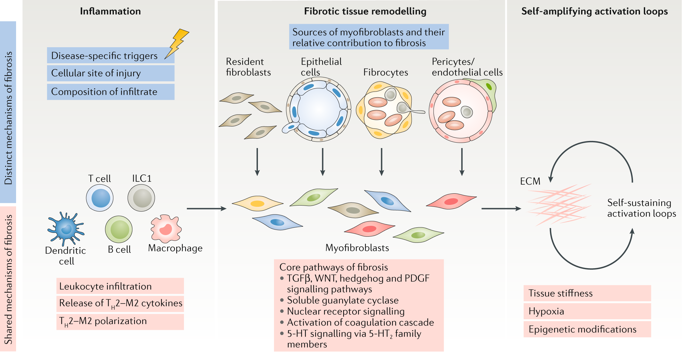当前位置:
X-MOL 学术
›
Nat. Rev. Rheumatol.
›
论文详情
Our official English website, www.x-mol.net, welcomes your
feedback! (Note: you will need to create a separate account there.)
Shared and distinct mechanisms of fibrosis.
Nature Reviews Rheumatology ( IF 29.4 ) Pub Date : 2019-11-11 , DOI: 10.1038/s41584-019-0322-7 Jörg H W Distler 1 , Andrea-Hermina Györfi 1 , Meera Ramanujam 2 , Michael L Whitfield 3 , Melanie Königshoff 4, 5, 6 , Robert Lafyatis 7
Nature Reviews Rheumatology ( IF 29.4 ) Pub Date : 2019-11-11 , DOI: 10.1038/s41584-019-0322-7 Jörg H W Distler 1 , Andrea-Hermina Györfi 1 , Meera Ramanujam 2 , Michael L Whitfield 3 , Melanie Königshoff 4, 5, 6 , Robert Lafyatis 7
Affiliation

|
Fibrosis is defined as an excessive deposition of connective tissue components and can affect virtually every organ system, including the skin, lungs, liver and kidney. Fibrotic tissue remodelling often leads to organ malfunction and is commonly associated with high morbidity and mortality. The medical need for effective antifibrotic therapies is thus very high. However, the extraordinarily high costs of drug development and the rare incidence of many fibrotic disorders hinder the development of targeted therapies for individual fibrotic diseases. A potential strategy to overcome this challenge is to target common mechanisms and core pathways that are of central pathophysiological relevance across different fibrotic diseases. The factors influencing susceptibility to and initiation of these diseases are often distinct, with disease-specific and organ-specific risk factors, triggers and sites of first injury. Fibrotic remodelling programmes with shared fibrotic signalling responses such as transforming growth factor-β (TGFβ), platelet-derived growth factor (PDGF), WNT and hedgehog signalling drive disease progression in later stages of fibrotic diseases. The convergence towards shared responses has consequences for drug development as it might enable the development of general antifibrotic compounds that are effective across different disease entities and organs. Technological advances, including new models, single-cell technologies and gene editing, could provide new insights into the pathogenesis of fibrotic diseases and the development of drugs for their treatment.
中文翻译:

共同和不同的纤维化机制。
纤维化被定义为结缔组织成分的过度沉积,几乎可以影响每个器官系统,包括皮肤、肺、肝和肾。纤维化组织重塑通常会导致器官功能障碍,并且通常与高发病率和死亡率有关。因此,对有效抗纤维化疗法的医学需求非常高。然而,药物开发的异常高昂的成本和许多纤维化疾病的罕见发病率阻碍了针对个别纤维化疾病的靶向治疗的发展。克服这一挑战的一个潜在策略是针对在不同纤维化疾病中具有中心病理生理相关性的共同机制和核心途径。影响这些疾病易感性和发病的因素通常是不同的,具有特定疾病和特定器官的风险因素、触发因素和首次受伤部位。具有共同纤维化信号反应的纤维化重塑程序,例如转化生长因子-β (TGFβ)、血小板衍生生长因子 (PDGF)、WNT 和刺猬信号,在纤维化疾病的后期推动疾病进展。朝着共同反应的趋同对药物开发产生了影响,因为它可能使开发出对不同疾病实体和器官有效的通用抗纤维化化合物成为可能。技术进步,包括新模型、单细胞技术和基因编辑,可以为纤维化疾病的发病机制和治疗药物的开发提供新的见解。具有共同纤维化信号反应的纤维化重塑程序,例如转化生长因子-β (TGFβ)、血小板衍生生长因子 (PDGF)、WNT 和刺猬信号,在纤维化疾病的后期推动疾病进展。朝着共同反应的趋同对药物开发产生了影响,因为它可能使开发出对不同疾病实体和器官有效的通用抗纤维化化合物成为可能。技术进步,包括新模型、单细胞技术和基因编辑,可以为纤维化疾病的发病机制和治疗药物的开发提供新的见解。具有共同纤维化信号反应的纤维化重塑程序,例如转化生长因子-β (TGFβ)、血小板衍生生长因子 (PDGF)、WNT 和刺猬信号,在纤维化疾病的后期推动疾病进展。朝着共同反应的趋同对药物开发产生了影响,因为它可能使开发出对不同疾病实体和器官有效的通用抗纤维化化合物成为可能。技术进步,包括新模型、单细胞技术和基因编辑,可以为纤维化疾病的发病机制和治疗药物的开发提供新的见解。WNT 和刺猬信号在纤维化疾病的后期推动疾病进展。朝着共同反应的趋同对药物开发产生了影响,因为它可能使开发出对不同疾病实体和器官有效的通用抗纤维化化合物成为可能。技术进步,包括新模型、单细胞技术和基因编辑,可以为纤维化疾病的发病机制和治疗药物的开发提供新的见解。WNT 和刺猬信号在纤维化疾病的后期推动疾病进展。朝着共同反应的趋同对药物开发产生了影响,因为它可能使开发出对不同疾病实体和器官有效的通用抗纤维化化合物成为可能。技术进步,包括新模型、单细胞技术和基因编辑,可以为纤维化疾病的发病机制和治疗药物的开发提供新的见解。
更新日期:2019-11-11
中文翻译:

共同和不同的纤维化机制。
纤维化被定义为结缔组织成分的过度沉积,几乎可以影响每个器官系统,包括皮肤、肺、肝和肾。纤维化组织重塑通常会导致器官功能障碍,并且通常与高发病率和死亡率有关。因此,对有效抗纤维化疗法的医学需求非常高。然而,药物开发的异常高昂的成本和许多纤维化疾病的罕见发病率阻碍了针对个别纤维化疾病的靶向治疗的发展。克服这一挑战的一个潜在策略是针对在不同纤维化疾病中具有中心病理生理相关性的共同机制和核心途径。影响这些疾病易感性和发病的因素通常是不同的,具有特定疾病和特定器官的风险因素、触发因素和首次受伤部位。具有共同纤维化信号反应的纤维化重塑程序,例如转化生长因子-β (TGFβ)、血小板衍生生长因子 (PDGF)、WNT 和刺猬信号,在纤维化疾病的后期推动疾病进展。朝着共同反应的趋同对药物开发产生了影响,因为它可能使开发出对不同疾病实体和器官有效的通用抗纤维化化合物成为可能。技术进步,包括新模型、单细胞技术和基因编辑,可以为纤维化疾病的发病机制和治疗药物的开发提供新的见解。具有共同纤维化信号反应的纤维化重塑程序,例如转化生长因子-β (TGFβ)、血小板衍生生长因子 (PDGF)、WNT 和刺猬信号,在纤维化疾病的后期推动疾病进展。朝着共同反应的趋同对药物开发产生了影响,因为它可能使开发出对不同疾病实体和器官有效的通用抗纤维化化合物成为可能。技术进步,包括新模型、单细胞技术和基因编辑,可以为纤维化疾病的发病机制和治疗药物的开发提供新的见解。具有共同纤维化信号反应的纤维化重塑程序,例如转化生长因子-β (TGFβ)、血小板衍生生长因子 (PDGF)、WNT 和刺猬信号,在纤维化疾病的后期推动疾病进展。朝着共同反应的趋同对药物开发产生了影响,因为它可能使开发出对不同疾病实体和器官有效的通用抗纤维化化合物成为可能。技术进步,包括新模型、单细胞技术和基因编辑,可以为纤维化疾病的发病机制和治疗药物的开发提供新的见解。WNT 和刺猬信号在纤维化疾病的后期推动疾病进展。朝着共同反应的趋同对药物开发产生了影响,因为它可能使开发出对不同疾病实体和器官有效的通用抗纤维化化合物成为可能。技术进步,包括新模型、单细胞技术和基因编辑,可以为纤维化疾病的发病机制和治疗药物的开发提供新的见解。WNT 和刺猬信号在纤维化疾病的后期推动疾病进展。朝着共同反应的趋同对药物开发产生了影响,因为它可能使开发出对不同疾病实体和器官有效的通用抗纤维化化合物成为可能。技术进步,包括新模型、单细胞技术和基因编辑,可以为纤维化疾病的发病机制和治疗药物的开发提供新的见解。











































 京公网安备 11010802027423号
京公网安备 11010802027423号